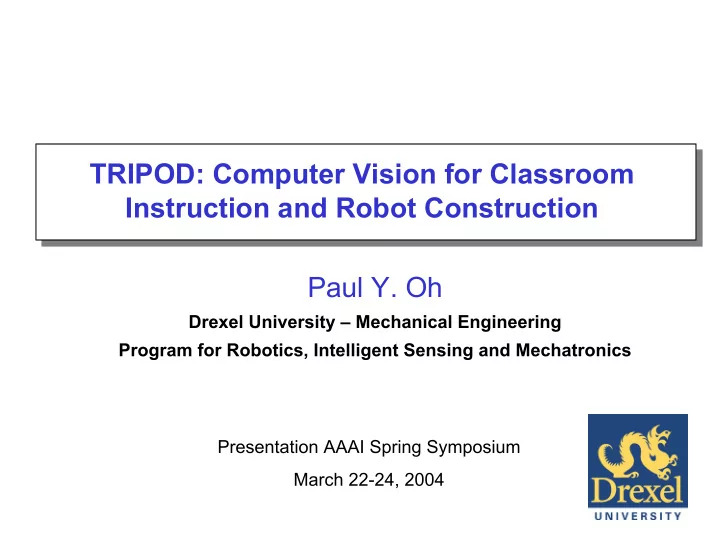

TRIPOD: Computer Vision for Classroom Instruction and Robot Construction Paul Y. Oh Drexel University – Mechanical Engineering Program for Robotics, Intelligent Sensing and Mechatronics Presentation AAAI Spring Symposium March 22-24, 2004 1
Motivation: Research in Seeing Robots and Mechanisms Head-Mounts for Alleviating Motion Sickness & Balance Disorders Visually Servoed Tracking IROS 2002 LEAP: Low Elevation Aerial Photography ICRA 2003 Visually Servoed Bipeds CQAR: Closed Quarter Aerial Robots IROS 2003
Motivation: Undergraduate Robotics and Outreach US FIRST – High Schools and ASME Future Drexel Teams?
Computer Vision for the Classroom? Vision Package Platform Hardware Pros Cons X-Vision, X-Vision 2 Unix Various Open, Libraries Setup difficult Intel Open CV Windows VFW Open, e-Community Setup difficult Matrox MIL Windows Proprietary Documentation Expensive Coreco Sherlock Windows Proprietary Turnkey Proprietary Matlab I/P Toolbox Unix, Windows VFW Robust No video Matlab I/A Toolbox Windows VFW Robust Must learn Matlab Common Denominators: Design Parameters • ANSI C/C++ • Teach Computer Vision! • Access to Windows PC • Affordable • No DirectX, ActiveX, MFC • Robust • Cost constraints • Customizable • Microsoft always changing!
Computer Vision for Robot Construction? Video vs. Images • Mechanism Dynamics • Bandwidth • Control Laws • Robustness • System Integration Need: Classroom training with realistic tools to build realistic systems
TRIPOD: Template for Real-time Image PrOcessing Development • Teach Computer Vision! - ANSI C/C++ - Avoids compiler specifics - Pointer to pixel data - Frame rate and Video • Customizable - Open-source - No royalties Input – Output Window • Affordable • Robust - TRIPOD and QCSDK are free - Logitech SDK - $50 USB camera - Windows Compatibility On-line Tutorial: http://www.boondog.com/
Philosophy: Learn Computer Vision - Not Compiler Steps 1. Open Visual C++ 2. Copy TRIPOD template 3. ANSI C/C++ on pixel data 4. Compile 5. Execute and see results Hardware Specs Used: Pentium 3 – 500 MHz – 256 MB RAM – LEGO Camera
Classroom Implementation: Envisioned Syllabus Description: Computer vision fundamentals namely segmentation, pattern recognition, edge detection and tracking for robotic systems Pre-requisites: Intro to C Programming, Linear Algebra Objectives: Provide students the fundamentals of computer vision. Emphasis is on understanding the physical principles governing image processing and applying them to solve engineering problems Text: Myler, H,. The Pocket Handbook of Image Processing Algorithms in C (ISBN: 0-13-642240-3) Schedule: Lecture Topic (3 Hrs/Week) 1 BMP Files, raster data, row-column vectors, pointers 2 Memory handling: negatives, thresholds, binary, brightness 3 Centroids, areas, clustering 4 TRIPOD exercises: threshold, binary, centroids 5 Color recognition and tracking 6 Kernels and edge detection 7 Pattern recognition: SSD Tracking 8 Image-based Visual-Servoing 9 Visual-Servoing Project 10 Project Presentation
Test Case: Independent Study Image analysis, edge detection Pattern recognition, SSD tracking Visual-Servoing Project http://www.pages.drexel.edu/~weg22/tutorials.html
Test Case: Independent Study TRIPOD: edge detection
TRIPOD: How it Works QCSDK (Low-level) • USB Interface • DirectX • Logitech API QCSDK TRIPOD (Hi-level) • Pointer to data • ANSI C/C++ • Minimal MFC • Hooks to API TRIPOD
Project: Wireless Imagery for C2 Augmentation Wireless 802.11b C2 CENTER PDA SCREEN VIEW Live view Processed Image (edge enhancement) Image retrieved from C2
Wireless Imagery for C2 Augmentation Video Demo
Project: Biomimic Human Head-Eye Motion for Servoing Two Rotational DOF Camera Point-of-View
Contributions • Free and open source package • Uses widely available and affordable cameras • ANSI C/C++ with minimum MFC • On-line tutorials and code • Integrate LEGO Vision Command with Mindstorms Conclusions • Suitable for Independent and Honors Study • Can affordably and effectively implement in classroom • Rapidly ascend CV learning curve • Apply concepts to prototype robot-camera systems
Recommend
More recommend